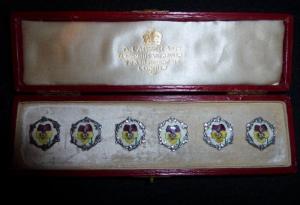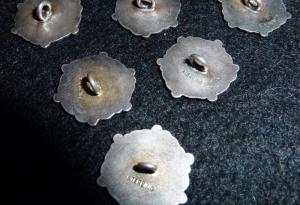Another Button Story
A new button will be posted on the Home page once per month.
Click on the photo to enlarge.
The topic for our October meeting was Flowers. When you start looking there are almost more designs of flowers on buttons than other subjects! I have chosen Pansies for the website flower.
Pictured is a delightful boxed set of sterling silver Pansy buttons with enamel decoration.
The following references are quoted from articles on various websites:-
The word "flower" comes from the Old French "flor," which was borrowed from the Latin word "flos" (or its expressive form "florem"), meaning "flower" or "blossom" from the Proto-Indo-European root "to thrive, to bloom".
The spelling "flour" was used for "flower" in English until the 17th century, before becoming specialized to mean ground grain, referring to the "finest part" of the grain, similar to how a flower is the finest part of a plant.
The word "pansy" is derived from the French word "pensée," which means "thought". This meaning was carried into Late Middle English in the 15th century, and the flower became associated with the concept of thought, remembrance, and thinking of others.
In the 19th Century, language of flowers, the Pansy reflects the meaning of “remembrance”. It was also a popular female name during the Victorian era and early 20th Century.
The Pansy is the floral symbol for the Zodiac sign Capricorn (December 22nd to January 19th) .



